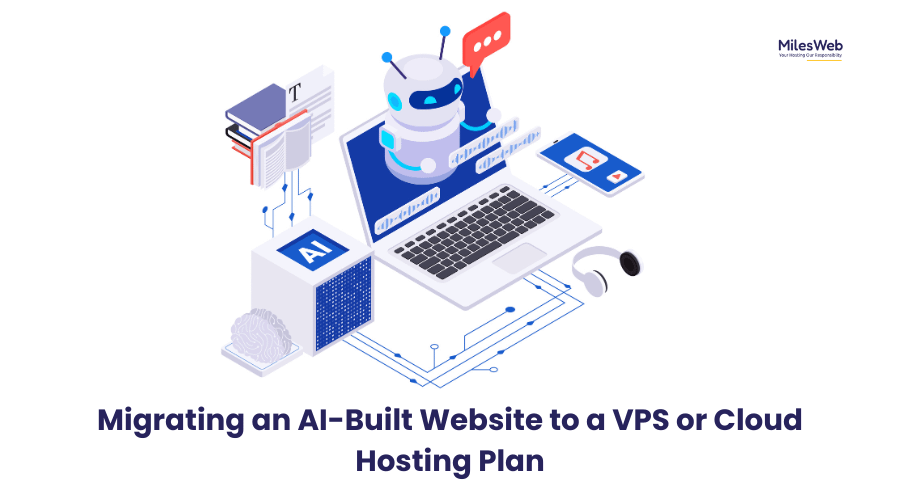Thanks to highly developed modern technology, today AI features can generate websites in mere minutes through prompts. Thus, the best AI website builders have transformed how people and businesses create websites. The sites, built through AI, are professional, functional, and mobile-friendly. However, if you use the default hosting provided by the builder, you will start to notice some limitations once you go live with your site.
If you buy professional email and your AI-built site is growing (an increase in traffic or a need for strong security), then it’s a good idea to migrate your website to a Virtual Private Server (VPS) or look for a cloud hosting plan. Both these options will offer your website scalability, performance, and reliability to ensure smooth operation.
This blog talks about the reasons, timing, and necessary steps of migrating an AI-built website to a VPS or cloud hosting.
Why Migrate an AI-Built Website?
Getting a website builder is a great option when starting a website. However, let your needs to improve dictate how you evolve. Below are some reasons that support the need to migrate your website.
Performance Bottlenecks
With cloud or VPS hosting, slow load times that arise from an increase in traffic or complex scripts are easily addressed due to the dedicated resources provided.
Customization Requirements
While customizing features is often available, some builders lock down backend control. With migration, you get root access (VPS) or conditionally unlimited scale (cloud) for deeper customization.
Security Measures and Compliance
VPS and cloud hosting allow businesses to configure custom firewalls and manage SSL and standardized GDPR control for websites that need more sophisticated security.
Business Agility
Operational demand cloud is more efficient and designed to scale, making it a powerful resource tool in VPS and cloud hosting for growing and seasonally spiking businesses.
Optimism
The custom hosting plan, complete with a domain and email, is powerful in setting up, adding to professionalism and brand image, and centering.
VPS and Cloud Hosting Comparison
● VPS Hosting
VPS is a technology that allows a physical server to be partitioned into virtual spaces. Compared to shared, you have access to better performance, control, and resources. It is ideal for businesses and sites that experience a predictable level of traffic.
● Cloud Hosting
Unlike VPS, which stores a site on a single server, Cloud hosting is designed to store a site on several servers. Should one server fail, another can take over for seamless performance. It is designed for businesses that experience a rapid or fluctuating increase in site traffic.
● In Summary
VPS is best for those who want control on a budget and with predictable traffic.
Expect sudden traffic spikes that can disrupt your site’s performance, then Cloud is for you.
How to Migrate an AI-Built Website
Although initially, migrating your AI-built site may seem to come with its own challenges, it can actually be as seamless as you want it to be with the right strategy. Here’s how.
1. Look At What Your AI Builder Allows You To Export
AI website builders vary in their offerings. Some will let you download the site code, media, and content in their entirety, while others will only allow partial downloads, resulting in the need to manually create the site on a new hosting plan. You need to check the documentation or reach out to support and find out what your options are.
2. Determine The Hosting Provider To Use
VPS or cloud hosting is what you need, but it should also be in line with the goals or objectives you have set for your website. Also consider:
- How resources are divided (CPU, RAM, bandwidth)
- Uptime guarantees
- The level of security
- Support services
- Migration assistance
3. Make a Copy of The Website
Website files and databases must be saved as backups so that nothing is lost in the process of migrating to the new website.
4. Configure Your Cloud Server or VPS
Upload the backed-up files or exported site code once the security fundamentals are configured: the firewall, SSL, and malware protection. Afterwards, you need to install a control panel (like cPanel, Plesk, or a managed dashboard).
5. Testing Should Be Done on a Staging Server
There’s no need to set up the domain just yet. For now, what you should focus on is ensuring that everything, including the features, designs, and scripts, is functioning as intended.
6. Update DNS Settings
At this point, record the date and time. Once your new hosting environment is ready, update your domain’s DNS records to point to your VPS or cloud server. This step makes your site live on the new host.
7. Monitor Post-Migration
Track down the rate of your website’s performance, downtime, and broken links. This step must be followed when the site is migrating or post-migrating to check its functionalities.
Best Practices for a Smooth Migration
- Plan Downtime: Avoid times when people will use the site most.
- Optimize Before Migration: Clear unnecessary plugins, unused media, and code for a smoother transition.
- Get Managed Services: If you are using a VPS or cloud hosting solution for the first time, it is better to connect directly with your service provider. Trustworthy hosting companies like MilesWeb offer managed hosting solutions, configure servers and maintain those consistently, without disturbing their clients.
Conclusion
With the artificial intelligence builder, the new site can be easily hosted on a VPS or cloud hosting plan. This is no longer a technical upgrade; it is an investment. With it comes autopilot control, active growth, performance flexibility, and the scale of growth that multi-builder platforms fail to offer.
VPS and cloud hosting need to grow, and with your business and the investment in your site, the automated intelligence builder websites are not just functional but resilient, secure, and ready for the future as well.


